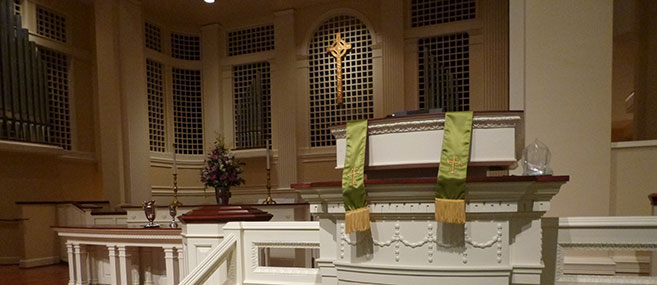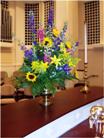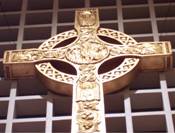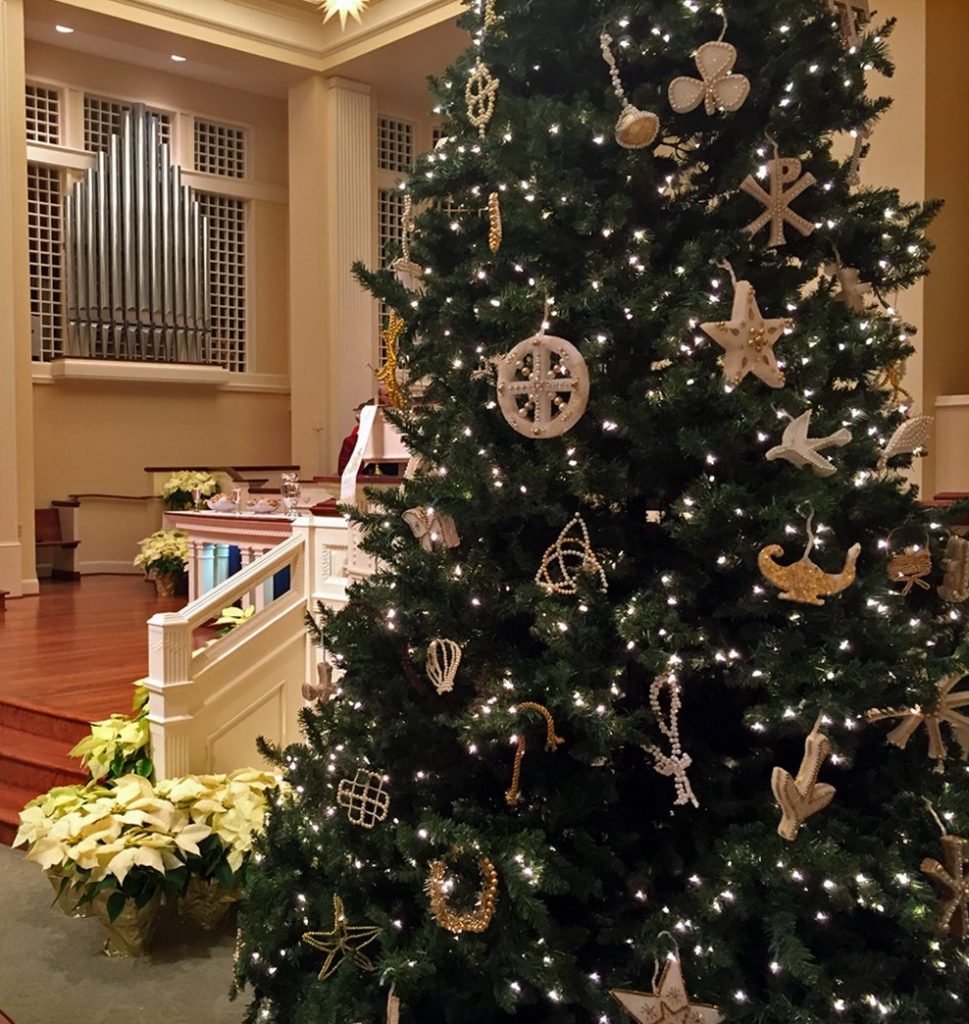
Symbolism has played an important part in the proclamation of the Christian faith. In the early church it was the means by which Christians could express their beliefs without jeopardizing their lives at the hands of those who sought to eradicate the church. In subsequent years the church has used symbolism to bring Christian ideas home to our minds and hearts. Our Sanctuary is rich in symbolism, which if properly understood and appreciated will add greatly to the enrichment of our worship.

As we approach the building, the spire pointing heavenward is a reminder of things above, where Christ is “exalted at the right hand of God” [Acts 2:33]. The cross atop the spire recalls the words of the Savior, “If I be lifted up, I will draw all unto myself” [John 12:32]. The sound of chimes playing from the spire calls us to worship and reminds us of the primacy of things spiritual.
We enter the building into the Narthex, a term which means a vestibule or anteroom. From the Narthex we enter the nave, which is the portion of the building occupied by the congregation during worship. A broad central aisle in the nave leads directly to the communion table in the Chancel. There are no barriers to the table, for all believers are invited to come and partake of the Sacrament.

The Chancel is that part of the church occupied by those who lead in worship — the minister, lay liturgists, choir, organist, and elders of the church when they administer the Sacrament of the Lord’s Supper. In the Chancel are the lectern (on your right), from which the Word of God is read; the pulpit (on your left), from which the Word of God is proclaimed; and the communion table, from which the Sacrament of the Lord’s Supper is celebrated. These three foci of Protestant worship receive equal attention in the arrangement of the Chancel.



Symbolism abounds in the Chancel. The communion table with the plate, cup and pitcher, are constant reminders to Christians of Christ’s broken body and shed blood, a sacrifice for all humanity. Nothing else is placed on the communion table except the elements used in the observance of the Sacrament of the Lord’s Supper. In the three panels beneath the communion table are symbolic roses, reminders of the messianic promise expressed in Isaiah 35:1, “the desert shall rejoice and blossom as a rose.”

Behind the communion table is the retable, on which are placed the candles and flowers. Candles are symbolic of Christ’s claim, “I am the light of the world” [John 8:12]. Flowers are used in the church as a reminder that God is the creator and sustainer of all life and has beautified the world with wonderful works of nature.

The cross hangs in the center of the organ screen, the wall behind the choir loft. This particular type of cross is known as the Celtic cross, as opposed to the plainer Latin cross as seen atop the spire. The origin of the Celtic cross is the Isle of Iona, off the coast of Scotland, and it dates back to ancient time. Superimposed on the cross is a circle, which is without beginning and without ending, symbolic of eternal life. The Celtic cross emphasizes the eternal effect of the redemption secured on the cross by the death of Christ.

Many symbols are carved into the cross. The figure at the bottom is the cock crowing, signifying Peter’s denial of his Lord. Next is a cluster of grapes, signifying the Sacrament of the Lord’s Supper. This motif is repeated several times on the cross. Next is a crown of thorns and three nails, symbolizing the suffering and death of our Lord. Next is the seamless robe of our Lord, for the possession of which the Roman soldiers cast lots, the lottery being indicated by the three dice. Around the four arms of the cross are the symbols for the four evangelists. At the bottom, the image of a winged man is used to represent Matthew, because his Gospel opens with the human genealogy of Christ. On the right crosspiece is the symbol for Mark, the winged lion, chosen because his Gospel opens with allusions to “one crying in the wilderness”. On the left crosspiece is the symbol for Luke, the winged calf, so used because Luke’s Gospel deals with the sacrificial work of Christ, a calf being the most common symbol of sacrifice. At the top appears the symbol for John, the eagle, selected because John expresses in his Gospel the divine nature of Christ in the most exalted terms to be found anywhere in the Bible.
At the very center of the cross is the phoenix, a legendary bird that lived to a great age. As the legend goes, when the end of the bird’s life grows near, it gathers a nest of sweet smelling spices and twigs. These are set on fire by the heat of the sun, and the phoenix is consumed in the fire. Out of the ashes the bird rises again, recreated and young. This is a widely used symbol for the resurrection.
On the right is the lectern, the reading desk from which the Bible lessons are read during the service. On its front is inscribed a “Chi Rho”. This is the oldest monogram used with reference to Christ. These two Greek letters, one imposed upon the other, are the first two letters in the word “Christ”.

On the left is the pulpit, the place from which the Word of God is preached. On it is a symbol composed of a Maltese cross superimposed on the sun. The sun in full ray is a Messianic symbol of and is based on the prophecy of Malachi 4:2, “But for you who revere my name the sun of righteousness shall rise with healing in its wings.” The cross is a stylized version of the Maltese cross. It derives its name from the Knights of Malta, who took as their responsibility the protection of Christian pilgrims on their way to Palestine in the 11th century to visit the Holy Sepulcher. It is often called the Regeneration Cross because it symbolizes the new birth.
Seasons and celebrations in the Church Year are marked by the changing colors of the lectern hanging and the stoles worn over the ministers’ robes. White is the color for Christmas and Easter as well as weddings, funerals, and memorial services. Purple is used during the preparatory seasons of Advent and Lent. Red reminds us of the flames of Pentecost, and green is used during the non-festival times of the year called ordinary time.

During the Advent and Christmas season, we have a Chrismon tree near the lectern decorated with handmade ornaments. Chrismons, meaning “Christ monograms,” traditionally are white and gold designs made from Christian symbols that signify Christ. Click here for more information detailing the Chrismons on our tree.